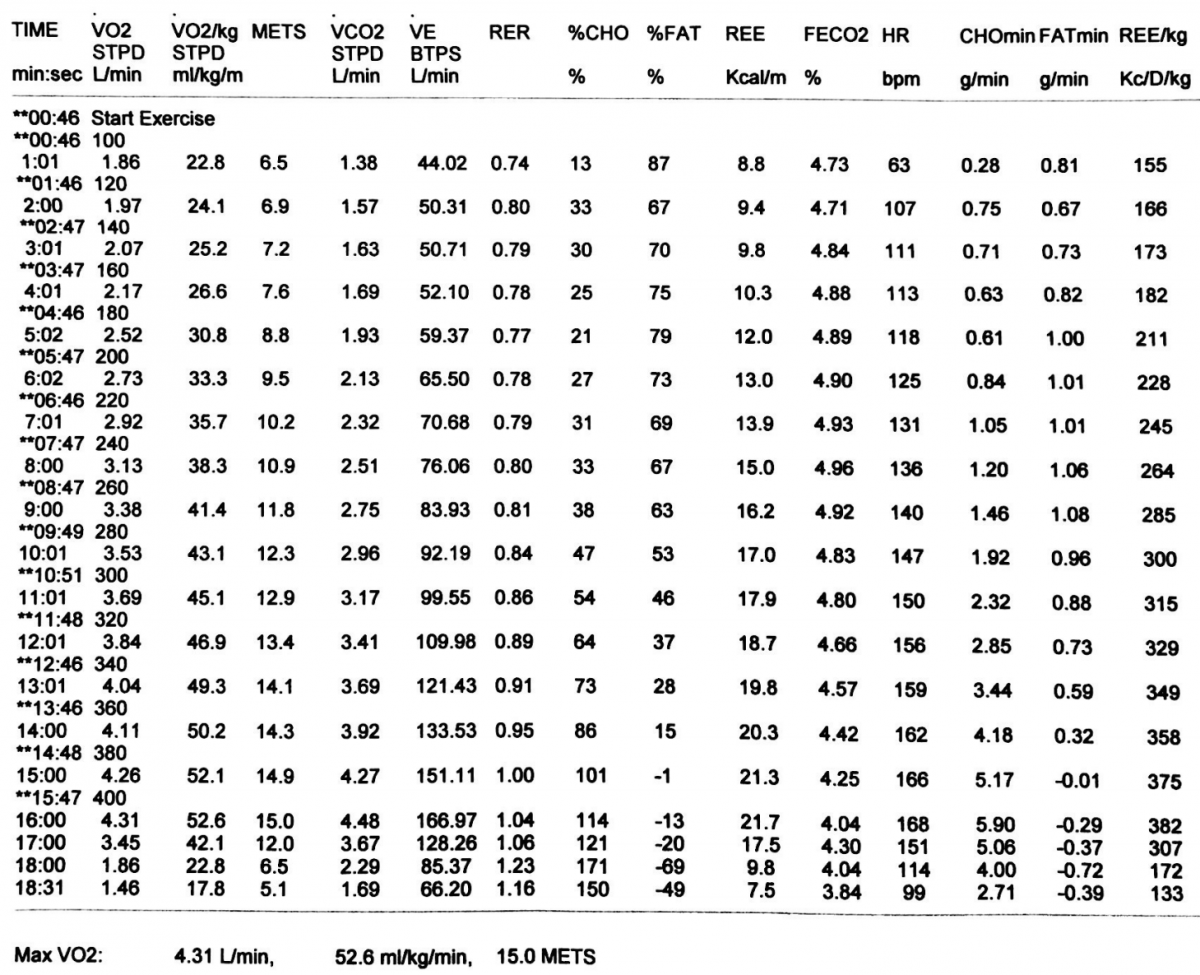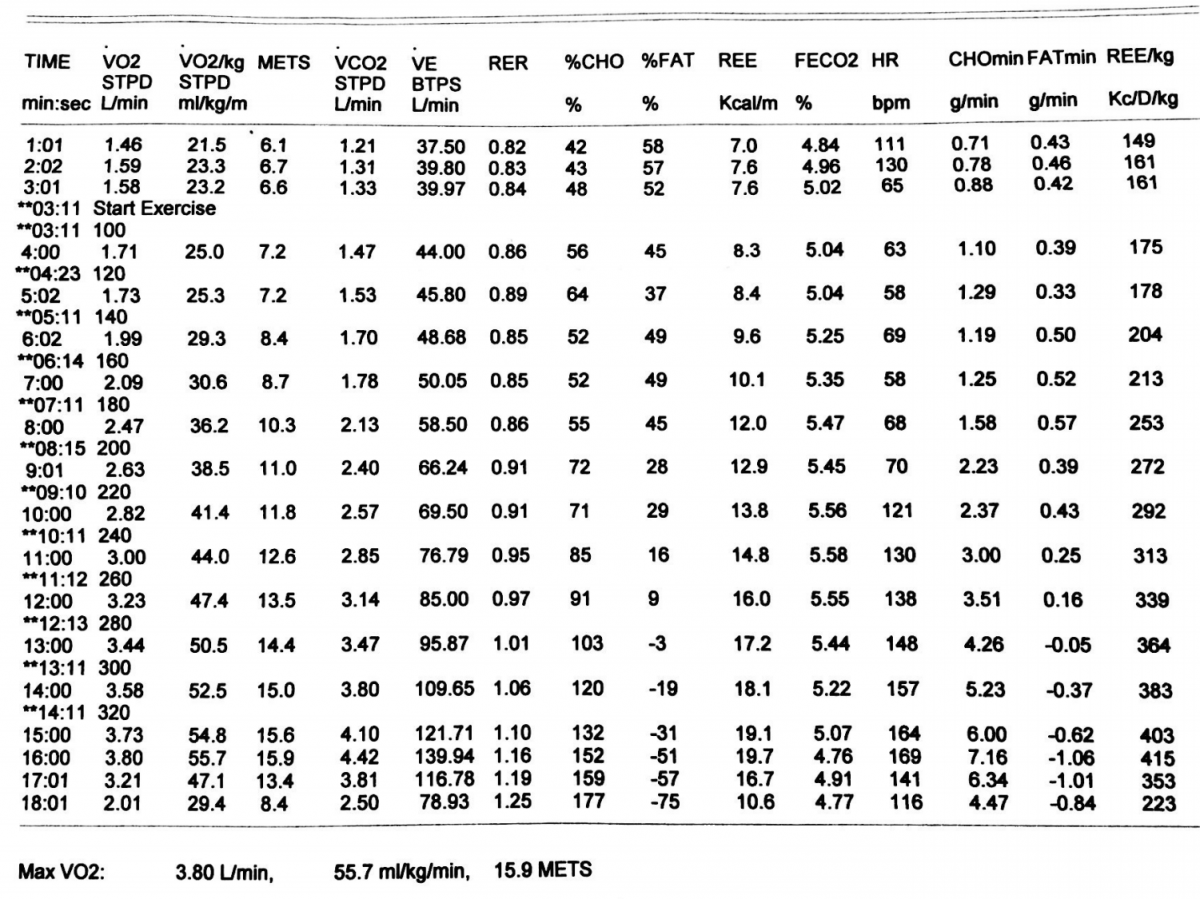Last week we announced our 90 Day Sugar Free Challenge, and also mentioned that Michael and Bryan would also be doing a VO2 max test with FasCat Coaching to learn more about their physiology. Understanding what our baseline VO2 and blood tests show is a key component to analyzing what changes, in any, will occur after 90 days without added sugar.
The VO2 max test is commonly thought of as what your O2 capacity is in ml / kg / min. So...milliliters of oxygen used per kilogram of body weight per minute. While the VO2 max number is an interesting data point, we're more focused on other things the test can show us - like RER, % CHO, % Fat, CHO burned g/min, and Fat burned g/min.
At the bottom of this article, we've published a screen shot of both Michael's and Bryan's full test data, but for the sake of keeping things a little more simple, this is what we found:
Note: "CHO" is an abbreviation for carbohydrate.
Michael:
 VO2 Max Test Michael (February 18, 2015):
VO2 Max Test Michael (February 18, 2015):

- Weight: 68.2 kg / 150 lbs
- Body Fat: 5.15%
- % CHO vs % Fat burned at 3.7 watts per kilogram: 91 CHO / 9 Fat
- CHO burned, grams per minute at 3.7 watts per kilogram: 3.51 grams per minute
- Fat burned, grams per minute at 3.7 watts per kilogram: 0.16 grams per minute
- Note: Michael's above numbers were recorded at 260 watts, slightly more than 3.7 watts per KG
- Weight: 81.8 kg / 180 lbs
- Body Fat: 8.14%
- % CHO vs % Fat burned at 3.7 watts per kilogram: 54 CHO / 46 Fat
- CHO burned, grams per minute at 3.7 watts per kilogram: 2.32 grams per minute
- Fat burned, grams per minute at 3.7 watts per kilogram: 0.88 grams per minute
- Note: Bryan's numbers were recorded at 300 watts, slightly less than 3.7 watts per KG
Our bodies are only about 25% efficient, and that is why we simply CAN'T intake that much food! The body can only consume and process roughly 300-350calories/hr depending on the athlete and ability of their GI system to handle the nutrients. Most research has shown the human body can absorb roughly 30-60g/hr of CHO. CHO from multiple sources (fructose / glucose mix) may increase that number to ~90g/hr. As someone like Michael looks to become more efficient, he might try ingesting around 28g/hr CHO given the bodies 25% efficiency target. With this lower level of CHO intake, the body may begin to look for other sources of energy. This is where it's important to keep in mind that your body has stores of energy that it can rely on in the event that you're running a caloric deficit.In practice this means that while Michael might burn 210.6 grams of carbohydrate per hour at that output, there's no way for him to replenish all of those calories, thus he'll need to rely on his body's stored energy to cover that deficit. In order to utilize more Fat as energy, Michael may also need to decrease the intensity of his workouts as less CHO will be available for quick energy. This is the primary reason why we're focused on teaching our bodies to burn more FAT: No matter how lean you are, your body still carries a significantly larger store of fat than it can carbohydrate. If an athlete can shift the % carbohydrate burned into burning more fat, that athlete will generally become more efficient and will be able to perform better with an energy deficit. We'll be keeping the blog updated regularly as we go through this test, be sure to follow us on Facebook or Twitter for updates! VO2 Max Test Bryan (February 18, 2015):
 VO2 Max Test Michael (February 18, 2015):
VO2 Max Test Michael (February 18, 2015):

